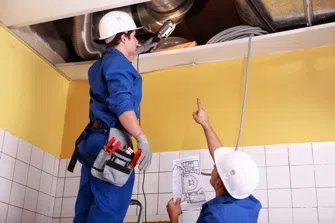Drastic price increases require a clearly defined sales process.
Equipment prices have increased significantly since the 13 SEER mandate. On average, we have seen a roughly 30% cost increase from manufacturers.
This has pushed many retail sales people beyond their ability to just naturally sell. When system prices were $4,000 to $6,000 just a few years ago, an average sales person was very capable. With the addition of new technology, we have seen many systems reach the $20,000 mark. Expecting your sales person to just walk in and do the same thing he has always done is not realistic. To be successful today, an hvacr company needs professional sales people and a committed sales process.
Without a clearly defined professional sales process, a company will lose opportunities to repair outdated equipment. No one wins when this happens. Here's how to create a sales process.
Step 1: Train Your Customer Service Group
Establish standards for your customer service group that convey a consistent message of quality service and a professional appearance. For example, at Thermal Services, our representatives answer the phone with "It is a great day at Thermal Services, how may I help you?" Also, when we dispatch a service technician, a customer-service representative calls the customer to let him know the tech is on the way.
These small things let customers know that they are dealing with a strong, reputable company that cares.
In addition, train service technicians not only on how to fix the equipment, but also how to effectively communicate with your customers. How does Thermal Services do this? One way is to hold "Monday morning kick-off meetings" every week. During these, we break down into small groups to discuss how the previous week's calls went and talk about how to build rapport with the customer. By doing this, we are able to share customer-communication techniques at a tech-to-tech level.
By prepping your customer with a truly professional experience via customer service representatives and technicians, you are giving your sales person the opportunity to walk into an environment in which trust has already been established.
Step 2. Hire Sales Professionals
Your sales person's job is to bring credibility to the product — not the product to the customer. This is why you must have professional sales people, not hvacr technicians parading as sales people. The main personality drivers of sales and technical understanding are vastly different. Just because a person excels on the technical side of the business doesn't mean he can sell.
We have made the commitment to hire professional sales people and teach them about our industry. For example, Lucas McAlpin, our residential sales manager, came to us from a pharmaceutical company. He has hired people that have sales experience but not the technical background. This works a whole lot better than trying to convert technical people into sales people.
Step 3. Present Benefits, Not Bells and Whistles
Your customers need to know how a system benefits them, not how it is wired. They expect you to know that. For example, our sales presentation book is all about comfort, reliability, and our company — not about the features of the equipment. We explain that the benefits being purchased are a quality, reliable, comfortable product from a reputable company — not the stages and the newest technology.
A sales opportunity is about sharing products that will make customers' lives better. This is an important point — you need to make their lives better, not yours. With this type of an attitude, your customers will see more value in your sales person's proposal.
Step 4. Treat Each Installation as Unique
The sales process does not stop there; your installers should be trained how to interact with customers while installing new equipment. They need to understand most equipment purchases are big events for customers. I had a customer tell me "Wade, I buy a new furnace once every 15 to 20 years, I know this is a daily and routine thing for you and your company. Please don't overlook that." This has stayed with me since the day I heard that. Customers should be given the royal treatment by all of your employees, not just your sales person.
Once the installation is complete, send a thank you card or gift basket. Make sure your customer feels the same value after the sale as they did before the sale. Your customer will be more likely to buy from you again, and not the other guy.
Step 5. Invest in Ongoing Training and Reinforcement
It takes determined leadership and commitment to maintain a professional sales organization. Hiring professional sales/communication trainers can be helpful. They specialize in teaching technicians how to effectively communicate technical things in a non-technical way.
An outside trainer brings perspective to not only you, but also your employees. They can bring best practices that they have seen work at other companies and push you and your employees out of your comfort zones. Companies traditionally keep doing the same thing over and over expecting different results. Once you check your ego and ask for a professional opinion, you have started the first step toward greater success.
Using these steps to create and maintain a professional sales process, we have seen our service-plan base grow along with continued sales and profits growth in our sales department. All of the areas discussed tie together and convey the same message — How may we serve you today?




